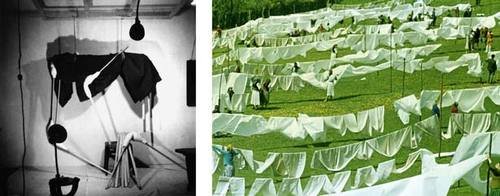Two solo shows
dal 26/6/2008 al 23/8/2008
Segnalato da
26/6/2008
Two solo shows
Galerie im Taxispalais, Innsbruck
Geta Bratescu presents an extensive range of her performances, films, drawings and objects that she created in Bucharest during the mid-seventies. Author of objects, textiles, environments, happenings, installations, performances, Ana Lupas has developed a complex nest of interventions which have systematically aimed at dismantling the traditional structure of the artwork.

Curated by: Alina Şerban in collaboration with Silvia Eiblmayr
Geta Brătescu is regarded as one of the most remarkable personalities of Romanian post-war avant-garde art. The exhibition at Galerie im Taxispalais Innsbruck represents the first extensive international presentation of her performances, films, drawings and objects that she created in Bucharest during the mid-seventies. Brătescu’s oeuvre results from a complex act of self-examination, which aims to objectify body and things, in a movement from the subjective and real towards a state of the objective and the abstraction.
In the 1970s, Geta Brătescu developed an intermedia concept for space-specific, performative works in which she investigated the relation between physiognomy, the body and the surrounding space. Her first recorded performance entitled "The Studio" (1978, camera: Ion Grigorescu) functions as a self-representational story exploring and processing the artist’s mental and physical environment. For Brătescu her studio is the space to redefine the Self, the space where the artist confesses freely her pleasure in playfulness; it is a stage where ideas come alive and where the performed gestures disclose alternative scripts to the day-to-day condition.
"Towards White" (1975), "Self-Portrait, Towards White" (1975) and "From Black to White" (1976) can be perceived as the sequences of a theatrical play, where the acting role, assumed by the artist, brings into discussion questions of self-identity and its cancellation and of the dematerialization of the object and the body in space.
In the film "Hands" (1977, camera: Ion Grigorescu), subtitled "For the eye, the hand of my body reconstitutes my portrait", the actors are the artist’s hands. Through a cinematic succession of suggestive gestural movements, the hands are seen as selecting, playing with small objects and then drawing their linear profile on the table, providing an alternative mode of reconstructing the artist’s portrait / identity.
Geta Brătescu was born in Ploiesti in 1926. She lives and works in Bukarest.
An exhibition catalogue is being published.
Ana Lupas figures among the most important international artists who, through a sophisticated process of creation, have continually expanded the understandings of Conceptual Art. Author of objects, textiles, environments, happenings, installations, performances, Ana Lupas has developed, starting from the mid-sixties, a complex nest of art interventions which have systematically aimed at dismantling the traditional structure of the artwork. Aspiring at a re-connection with the natural, at a rehabilitation of a virtual universal harmony, her performative installations and objects acquire utopian feature and presence.
The exhibition at Galerie im Taxispalais is focusing on two extensive outdoor installations produced during the mid-sixties and beginning of the seventies. 1970 Ana Lupas created the first large "Humid Installation" in Mârgău village, Transylvania which was realized with the help of 100 inhabitants of the village. Dozens of lines hung with wet, white linen were drawn over the whole of a hill, modulating the space, aiming to an infinite dimension and to a global natural continuation.
Already in 1964 Lupas created the work "Solemn Process", minimalist objects manufactured of straw in various dimensions: steles, wreaths and circles which were installed and arranged outdoors and inside the village’s houses. Involving the people in the production of these objects, "Solemn Process" embodies a traditional ritual whose solemnity generates not only the production of formal structures beautiful in their representation which melt within the rural surroundings, but also a new reconsideration of the conditions of creation of the art object.
In her later process-related steps Lupas transformed some of her early works by conveying them into new materials. For example, she created linen-formed sheets out of bitumen-saturated textile, paper or aluminum; for her straw objects she produced closed, sculptural plate repositories which she entitled "cans". Lupas shows a space-filling installation of these sculptures, whose interior is not revealed anymore, together with two large tableaus of images from 1964. Further on show is an indoor version of "Humid Installation".
Ana Lupas was born in Cluj in 1940. She lives and works in Cluj.
An exhibition catalogue is being published.
Information
Karin Jaschke, Press and Publicity, karin.jaschke@tirol.gv.at
Silvia Eiblmayr, Director
Thanks to
Promocult – Project supported by Ministry of Culture and Cults, Romania
Romanian Cultural Institute, Vienna
Centre for Visual Introspection, Bukarest
Opening: Friday, 27 June 2008, 7 pm
Galerie im Taxispalais
Maria-Theresien Strasse 45 - Innsbruck
Opening times: Tues-Sun 11 am - 6 pm, Thurs 11 am - 8 pm



